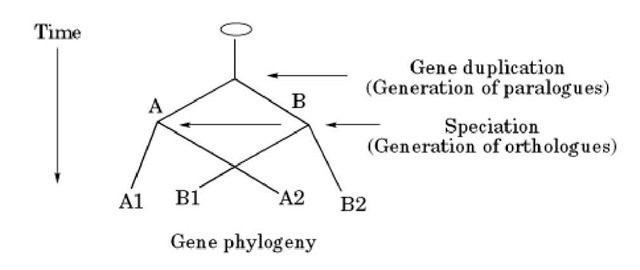Orthologous genes are two or more genes whose follows the speciation process, and they have usually the same function in each resulting species; that is, a particular gene in the ancestral will be duplicated in the two different species following speciation and will usually be maintained in each, because both species will require the function of that gene (Fig. 1) (1). These genes differ from , which diverged before or after speciation as a result of and usually have different functions. For example, the genes for the a and b polypeptide chains of hemoglobin and that for myoglobin are homologous but paralogous, whereas the hemoglobin a chains from different species are orthologous; similarly, the b chains and myoglobins from different species are orthologous. Only comparisons of orthologous genes can be used to reconstruct species phylogenies.
Figure 1. Generation of orthologous and paralogous genes (1).
It is often difficult to distinguish orthologous genes from paralogous genes. However, analysis has shown that some genes have a single version in a genome. Therefore, if this is the case in two or more species, there is a strong possibility that these genes are orthologous. If the gene is a member of a known , there is a distinct probability that it is a paralogous gene, depending on the number of genes in the family, because the gene could be a product of gene duplication before or after speciation.
Orthologous gene pairs are useful for estimating the rate of nucleotide substitution and species phylogenies. When the time since two species diverged (Ts) is known from the fossil record, it follows that the orthologous pairs should also have diverged at the time of species divergence. Therefore, the rate of nucleotide substitution for the gene (v) can be estimated by dividing the number of nucleotide substitutions (Kn) between orthologous gene pairs by two times of the divergence time between the two species
Two homologous genes sampled from the gene families between two species are often paralogous, rather than orthologous. If the two genes are paralogous, the divergence time of these genes (Tg) must have been earlier than the speciation time (T >Ts). If the divergence time of those genes is mistakenly assumed to be the divergence time between the species, the divergence time of the genes will be underestimated and will lead to overestimation of the rate of nucleotide substitution (K/(2Tg) >v). Thus, it is important to use only orthologous genes in estimating the rate of nucleotide substitution and the times of speciation.
There have been many recent advances in genome analysis, and as a result complete genomes are known. Those of two species can be compared to determine whether the physical order of genes in the genomes is conserved between different species. To accomplish this, it is vital to distinguish orthologous genes from paralogous genes. By focusing on orthologous genes, it is possible to trace changes in gene location during evolution because of the one-to-one correspondence in gene location between genomes, unless gene duplication takes place after speciation.

